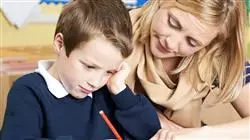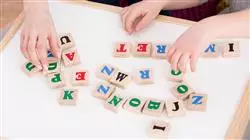University certificate
The world's largest faculty of education”
Introduction to the Program
Schools need teachers specialized in Therapeutic Pedagogy. Make progress in your professional field with this Professional master’s degree"

Nowadays, teaching professionals have found in new technologies the necessary tools to be able to teach their subject in a much more attractive way and also achieving the motivation of their students, but also with them they have managed to reach in a suitable way the hearing impaired, visually impaired or cognitively handicapped students. A program that clearly favors the personal development and improvement of the quality of life of students with special educational needs.
The ability of teachers to detect students with learning disabilities, the adaptation of content, as well as their coordination with professionals from other disciplines is key to achieve adequate learning progress by students with functional and cognitive diversity. To do so, you need an advanced knowledge of neurodevelopmental disorders, which is essential to be able to successfully carry out your professional performance. TECH offers teachers the most up-to-date knowledge in this field, with the main objective of advancing their careers and achieving the best results with their students.
To this end, this university program has, since its inception, delved into the evolution of the concept of functional diversity, as well as the different cognitive disorders and illnesses that may be present in the students it teaches. The multimedia teaching material and simulations of real cases will take you deeper into the disorders that affect key senses such as vision, hearing or child communication. In addition, it will allow you to delve into ICT and emerging methodologies currently applied in educational centers.
A Professional master’s degree, which provides the professional with the latest knowledge in Therapeutic Pedagogy in a comfortable and flexible way. Thus, students who study this program only need an electronic device with an Internet connection that allows them to access the virtual platform where the complete syllabus of this course is housed. In addition, if desired, students can distribute the teaching load according to their needs. Students are provided with facilities that allow them to acquire a quality university education while at the same time making their work and/or personal responsibilities compatible.
Thanks to this university program you will be able to properly assess your students with spatial needs with the use of ICT"
This Professional master’s degree in Therapeutic Pedagogy contains the most complete and up-to-date educational program on the market. The most important features include:
- Case studies presented by experts in Pedagogy and Education
- The graphic, schematic, and practical contents with which they are created, provide scientific and practical information on the disciplines that are essential for professional practice
- Practical exercises where the self-assessment process can be carried out to improve learning
- Its special emphasis on innovative methodologies
- Theoretical lessons, questions to the expert, debate forums on controversial topics, and individual reflection work
- Content that is accessible from any fixed or portable device with an Internet connection
TECH boosts your professional career with the latest knowledge in Therapeutic Pedagogy. Enroll now”
The program’s teaching staff includes professionals from the sector who contribute their work experience to this program, as well as renowned specialists from leading societies and prestigious universities.
The multimedia content, developed with the latest educational technology, will provide the professional with situated and contextual learning, i.e., a simulated environment that will provide immersive knowledge programmed to learn in real situations.
This program is designed around Problem-Based Learning, whereby the professional must try to solve the different professional practice situations that arise throughout the program. For this purpose, the student will be assisted by an innovative interactive video system created by renowned and experienced experts.
With this program you will learn in depth about the different educational interventions that can be carried out according to the different stages of development and disorders that your students have"

You are looking at a flexible Professional master’s degree. Access the resources you need to teach students with cognitive diversity at any time"
Why study at TECH?
TECH is the world’s largest online university. With an impressive catalog of more than 14,000 university programs available in 11 languages, it is positioned as a leader in employability, with a 99% job placement rate. In addition, it relies on an enormous faculty of more than 6,000 professors of the highest international renown.

Study at the world's largest online university and guarantee your professional success. The future starts at TECH”
The world’s best online university according to FORBES
The prestigious Forbes magazine, specialized in business and finance, has highlighted TECH as “the world's best online university” This is what they have recently stated in an article in their digital edition in which they echo the success story of this institution, “thanks to the academic offer it provides, the selection of its teaching staff, and an innovative learning method aimed at educating the professionals of the future”
A revolutionary study method, a cutting-edge faculty and a practical focus: the key to TECH's success.
The most complete study plans on the university scene
TECH offers the most complete study plans on the university scene, with syllabuses that cover fundamental concepts and, at the same time, the main scientific advances in their specific scientific areas. In addition, these programs are continuously being updated to guarantee students the academic vanguard and the most in-demand professional skills. In this way, the university's qualifications provide its graduates with a significant advantage to propel their careers to success.
TECH offers the most comprehensive and intensive study plans on the current university scene.
A world-class teaching staff
TECH's teaching staff is made up of more than 6,000 professors with the highest international recognition. Professors, researchers and top executives of multinational companies, including Isaiah Covington, performance coach of the Boston Celtics; Magda Romanska, principal investigator at Harvard MetaLAB; Ignacio Wistumba, chairman of the department of translational molecular pathology at MD Anderson Cancer Center; and D.W. Pine, creative director of TIME magazine, among others.
Internationally renowned experts, specialized in different branches of Health, Technology, Communication and Business, form part of the TECH faculty.
A unique learning method
TECH is the first university to use Relearning in all its programs. It is the best online learning methodology, accredited with international teaching quality certifications, provided by prestigious educational agencies. In addition, this disruptive educational model is complemented with the “Case Method”, thereby setting up a unique online teaching strategy. Innovative teaching resources are also implemented, including detailed videos, infographics and interactive summaries.
TECH combines Relearning and the Case Method in all its university programs to guarantee excellent theoretical and practical learning, studying whenever and wherever you want.
The world's largest online university
TECH is the world’s largest online university. We are the largest educational institution, with the best and widest online educational catalog, one hundred percent online and covering the vast majority of areas of knowledge. We offer a large selection of our own degrees and accredited online undergraduate and postgraduate degrees. In total, more than 14,000 university degrees, in eleven different languages, make us the largest educational largest in the world.
TECH has the world's most extensive catalog of academic and official programs, available in more than 11 languages.
Google Premier Partner
The American technology giant has awarded TECH the Google Google Premier Partner badge. This award, which is only available to 3% of the world's companies, highlights the efficient, flexible and tailored experience that this university provides to students. The recognition as a Google Premier Partner not only accredits the maximum rigor, performance and investment in TECH's digital infrastructures, but also places this university as one of the world's leading technology companies.
Google has positioned TECH in the top 3% of the world's most important technology companies by awarding it its Google Premier Partner badge.
The official online university of the NBA
TECH is the official online university of the NBA. Thanks to our agreement with the biggest league in basketball, we offer our students exclusive university programs, as well as a wide variety of educational resources focused on the business of the league and other areas of the sports industry. Each program is made up of a uniquely designed syllabus and features exceptional guest hosts: professionals with a distinguished sports background who will offer their expertise on the most relevant topics.
TECH has been selected by the NBA, the world's top basketball league, as its official online university.
The top-rated university by its students
Students have positioned TECH as the world's top-rated university on the main review websites, with a highest rating of 4.9 out of 5, obtained from more than 1,000 reviews. These results consolidate TECH as the benchmark university institution at an international level, reflecting the excellence and positive impact of its educational model.” reflecting the excellence and positive impact of its educational model.”
TECH is the world’s top-rated university by its students.
Leaders in employability
TECH has managed to become the leading university in employability. 99% of its students obtain jobs in the academic field they have studied, within one year of completing any of the university's programs. A similar number achieve immediate career enhancement. All this thanks to a study methodology that bases its effectiveness on the acquisition of practical skills, which are absolutely necessary for professional development.
99% of TECH graduates find a job within a year of completing their studies.
Professional Master's Degree in Therapeutic Pedagogy
Considering the recent development of this area, proper to the field of education, TECH Global University has decided to create this program focused on the theoretical-practical applications of the studies on special education that underlie the pillars of functional diversity. Based on the historical evolution of its conceptualization, the curriculum covers the psycho-pedagogical intervention frameworks available to address the developmental variables present in children and pre-adolescents affected by different neurodevelopmental disorders. It also offers the necessary tools for the diagnosis and management of intellectual disability, attention deficit, hyperactivity and autism, as well as diseases that affect motor skills and impede communication. Thanks to this complete course, professionals will acquire the skills to coordinate innovative strategies that simultaneously facilitate the teaching-learning processes and placate the complications caused by such conditions through cognitive rehabilitation.
Specialize with the Professional Master's Degree in Therapeutic Pedagogy
With this postgraduate course at TECH it is possible to master the planning and execution processes of educational adaptation projects, through the use of emerging methodologies that follow the normative frameworks outlined by UNESCO. With the background obtained throughout the 12 months, teachers and psychologists will be able to establish measures with a multidisciplinary approach, focused on the individualization of needs and aimed at promoting inclusion in the classroom and school. In addition, they will be qualified to develop systematized diagnostic protocols that favor the early detection of difficulties, action frameworks that can be adjusted to the requirements of each student and evaluation itineraries, where both the relevance of interventions and their impact on the child's well-being, as well as the degree of effectiveness in their integral development, are assessed. In this way, graduates will be characterized by their excellent performance in the daily exercise of psycho-pedagogical work, since they will provide quality care that guarantees accessibility and improvement of academic performance, promotes social inclusion and contributes to health promotion.







